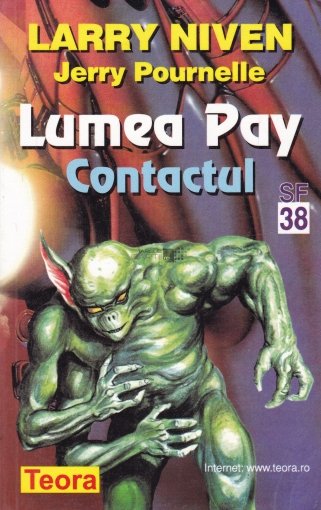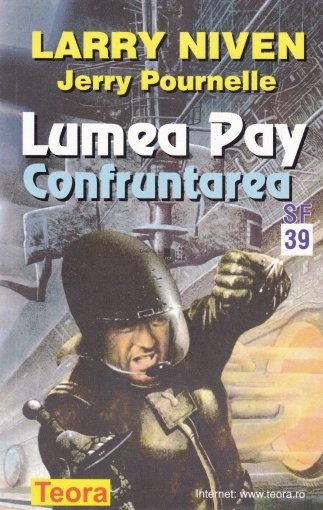


Books in series

Future History
1980

The Mote in God's Eye
1974

The Gripping Hand
1993

Outies
2010

Lumea Pay - Contactul
1999

Lumea Pay - Confruntarea
1974
Authors

Laurence van Cott Niven's best known work is Ringworld (Ringworld, #1) (1970), which received the Hugo, Locus, Ditmar, and Nebula awards. His work is primarily hard science fiction, using big science concepts and theoretical physics. The creation of thoroughly worked-out alien species, which are very different from humans both physically and mentally, is recognized as one of Niven's main strengths. Niven also often includes elements of detective fiction and adventure stories. His fantasy includes The Magic Goes Away series, which utilizes an exhaustible resource, called Mana, to make the magic a non-renewable resource. Niven created an alien species, the Kzin, which were featured in a series of twelve collection books, the Man-Kzin Wars. He co-authored a number of novels with Jerry Pournelle. In fact, much of his writing since the 1970s has been in collaboration, particularly with Pournelle, Steven Barnes, Brenda Cooper, or Edward M. Lerner. He briefly attended the California Institute of Technology and graduated with a Bachelor of Arts in mathematics (with a minor in psychology) from Washburn University, Topeka, Kansas, in 1962. He did a year of graduate work in mathematics at the University of California at Los Angeles. He has since lived in Los Angeles suburbs, including Chatsworth and Tarzana, as a full-time writer. He married Marilyn Joyce "Fuzzy Pink" Wisowaty, herself a well-known science fiction and Regency literature fan, on September 6, 1969. Niven won the Hugo Award for Best Short Story for Neutron Star in 1967. In 1972, for Inconstant Moon, and in 1975 for The Hole Man. In 1976, he won the Hugo Award for Best Novelette for The Borderland of Sol. Niven has written scripts for various science fiction television shows, including the original Land of the Lost series and Star Trek: The Animated Series, for which he adapted his early Kzin story The Soft Weapon. He adapted his story Inconstant Moon for an episode of the television series The Outer Limits in 1996. He has also written for the DC Comics character Green Lantern including in his stories hard science fiction concepts such as universal entropy and the redshift effect, which are unusual in comic books. http://us.macmillan.com/author/larryn...

Dr Jerry Eugene Pournelle was an American science fiction writer, engineer, essayist, and journalist, who contributed for many years to the computer magazine Byte, and from 1998 until his death maintained his own website and blog. From the beginning, Pournelle's work centered around strong military themes. Several books describe the fictional mercenary infantry force known as Falkenberg's Legion. There are strong parallels between these stories and the Childe Cycle mercenary stories by Gordon R. Dickson, as well as Heinlein's Starship Troopers, although Pournelle's work takes far fewer technological leaps than either of these. Pournelle spent years working in the aerospace industry, including at Boeing, on projects including studying heat tolerance for astronauts and their spacesuits. This side of his career also found him working on projections related to military tactics and probabilities. One report in which he had a hand became a basis for the Strategic Defense Initiative, the missile defense system proposed by President Ronald Reagan. A study he edited in 1964 involved projecting Air Force missile technology needs for 1975. Dr. Pournelle would always tell would-be writers seeking advice that the key to becoming an author was to write—a lot. “And finish what you write,” he added in a 2003 interview. “Don’t join a writers’ club and sit around having coffee reading pieces of your manuscript to people. Write it. Finish it.” Pournelle served as President of the Science Fiction and Fantasy Writers of America in 1973.

Dr. J.R. Pournelle is an archaeologist and anthropologist best known for reconstructing landscapes surrounding ancient cities. A Research Fellow at the University of South Carolina’s School of The Environment, and past Mesopotamian Fellow of the American School of Oriental Research, her work in Turkey, Iraq, and the Caucasus has been featured in Science Magazine, the New York Times; on The Discovery Channel; and on a National Geographic Television segment aired in January, 2012. In a former life, she received numerous decorations for service as a United States Army intelligence officer and arms control negotiator, and as a civilian directed reconstruction work in Iraq. Pournelle received the South Carolina Poetry Initiative Book Prize, for Excavations, A City Cycle, Poems 1989 - 2004, released by the University of South Carolina Press in October, 2011.